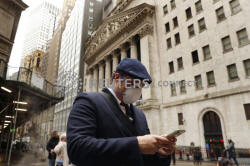Volatility in U.S. stocks jumps as investors brace for Senate 'blue
sweep'
 Send a link to a friend
Send a link to a friend
 [January 05, 2021] By
April Joyner [January 05, 2021] By
April Joyner
NEW YORK (Reuters) -Expectations for market
gyrations are rising as investors face U.S. Senate runoffs in Georgia on
Tuesday that will determine which party controls Congress, amid a
resurgence in coronavirus cases.
The Cboe Volatility Index, known as Wall Street's "fear gauge," on
Monday notched its highest closing level since Nov. 5, at 26.97, while
posting its biggest one-day gain since late October.
The VIX futures curve, which reflects longer-term expectations for
market volatility, has also inverted for the first time since early
November. An inversion of the curve suggests investors view the
short-term outlook as more uncertain than the longer-term.
If either of the incumbents, Senators Kelly Loeffler and David Perdue,
wins in Georgia, Republicans will maintain control of the Senate. But
victories by challengers Raphael Warnock and Jon Ossoff would give
control of the Senate - and Congress - to the Democratic party via a
tiebreaker vote from Vice President-elect Kamala Harris.

While a "blue sweep" of Congress could usher in greater fiscal stimulus
to aid the coronavirus-ravaged economy, it could also pave the way for
President-elect Joe Biden to push through a more aggressive policy
agenda, including greater corporate regulation and higher taxes. That
prospect has troubled some investors on Wall Street.
"The 'blue sweep' does create some policy implications that need to be
addressed," said Arnim Holzer, macro and correlation defense strategist
at EAB Investment Group. "Those two barbells are keeping vol elevated."
Overall, implied volatility - the measure of anticipated market moves
embedded in options prices - has jumped far ahead of realized
volatility, or actual stock movements.
[to top of second column] |

A man wears a protective mask as he walks past the New York Stock
Exchange on the corner of Wall and Broad streets during the
coronavirus outbreak in New York City, New York, U.S., March 13,
2020. REUTERS/Lucas Jackson

According to data from Susquehanna Financial Group, the gap between implied and
realized volatility is near its highest level in two years for the SPDR S&P 500
Trust, which tracks the benchmark U.S. stock index.
The gap is similarly wide for several U.S. exchange-traded funds in technology
and healthcare, sectors seen as prime targets for stricter regulation under a
Democratic Congress.
Christopher Murphy, Susquehanna's co-head of derivatives strategy, anticipates
implied volatility will decline soon after the Georgia runoffs, as it did after
the presidential election.
Yet this time around, concerns about the COVID-19 resurgence may keep volatility
elevated even after the runoff, said Amy Wu Silverman, equity derivatives
strategist at RBC Capital Markets.
"A 'blue sweep' would certainly have implications for the market, but I don't
see current volatility as specifically having to do with an administration
change," she wrote in an email to Reuters.
(Reporting by April Joyner; Editing by Lincoln Feast.)
[© 2021 Thomson Reuters. All rights
reserved.] Copyright 2021 Reuters. All rights reserved. This material may not be published,
broadcast, rewritten or redistributed.
Thompson Reuters is solely responsible for this content.
 |